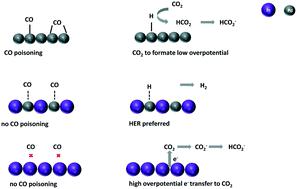当前位置:
X-MOL 学术
›
Catal. Sci. Technol.
›
论文详情
Our official English website, www.x-mol.net, welcomes your
feedback! (Note: you will need to create a separate account there.)
CO2 electroreduction on bimetallic Pd–In nanoparticles
Catalysis Science & Technology ( IF 4.4 ) Pub Date : 2020-06-16 , DOI: 10.1039/d0cy00831a Davide Pavesi 1, 2, 3, 4, 5 , Farhan S. M. Ali 6, 7, 8, 9, 10 , Dimitra Anastasiadou 3, 11, 12, 13 , Tanja Kallio 6, 7, 8, 9, 10 , Marta Figueiredo 3, 11, 12, 13 , Gert-Jan M. Gruter 1, 2, 3, 14, 15 , Marc T. M. Koper 3, 4, 5, 16 , Klaas Jan P. Schouten 1, 2, 3, 14, 15
Catalysis Science & Technology ( IF 4.4 ) Pub Date : 2020-06-16 , DOI: 10.1039/d0cy00831a Davide Pavesi 1, 2, 3, 4, 5 , Farhan S. M. Ali 6, 7, 8, 9, 10 , Dimitra Anastasiadou 3, 11, 12, 13 , Tanja Kallio 6, 7, 8, 9, 10 , Marta Figueiredo 3, 11, 12, 13 , Gert-Jan M. Gruter 1, 2, 3, 14, 15 , Marc T. M. Koper 3, 4, 5, 16 , Klaas Jan P. Schouten 1, 2, 3, 14, 15
Affiliation

|
CO2 electroreduction powered by renewable energy is an attractive strategy to recycle air-based carbon. One of the current challenges for the scale up of the technology is that the catalysts that show high faradaic yield at high current density (post-transitional metals such as In, Sn, Bi, Pb) suffer from very high overpotentials of more than 1 V. On the other hand, Pd can convert CO2 to formate with almost no overpotential, but is readily poisoned by CO and deactivates when trying to reach industrially relevant currents. In this work we show the effect of the interaction of In and Pd in bimetallic nanoparticles, reaching the conclusion that this interaction causes a loss of selectivity towards formate and at the same time suppresses CO poisoning of Pd sites. The results of the catalyst characterization suggest the formation of intermetallic PdIn compounds that in turn cause the aforementioned behavior. Based on these results, it seems that geometric and electronic effects in Pd based intermetallic compounds can alleviate CO poisoning on Pd sites. In the case of PdIn intermetallics this leads to the loss of CO2 reduction activity, but this strategy may be useful for other electrochemical reactions that suffer from the same problem of deactivation. It remains to be seen if intermetallic compounds of Pd with other elements can yield viable CO2 reduction catalysts.
中文翻译:

双金属Pd-In纳米颗粒上的CO2电还原
由可再生能源驱动的CO 2电解还原是一种有吸引力的策略,可回收基于空气的碳。该技术目前面临的挑战之一是在高电流密度下显示出高法拉第产率的催化剂(过渡金属,例如In,Sn,Bi,Pb等)具有超过1 V的非常高的过电势另一方面,Pd可以转化CO 2几乎没有过电位形成,但很容易被一氧化碳中毒并在试图达到与工业相关的电流时会失活。在这项工作中,我们显示了In和Pd在双金属纳米粒子中的相互作用的影响,得出的结论是,这种相互作用会导致对甲酸酯的选择性丧失,并同时抑制Pd位点的CO中毒。催化剂表征的结果表明,金属间PdIn化合物的形成反过来引起上述行为。基于这些结果,似乎在基于Pd的金属间化合物中的几何和电子效应可以减轻Pd部位的CO中毒。在PdIn金属间化合物的情况下,这会导致CO 2的损失还原活性,但是该策略可能对遭受相同失活问题的其他电化学反应有用。Pd与其他元素的金属间化合物能否产生可行的CO 2还原催化剂仍有待观察。
更新日期:2020-07-06
中文翻译:

双金属Pd-In纳米颗粒上的CO2电还原
由可再生能源驱动的CO 2电解还原是一种有吸引力的策略,可回收基于空气的碳。该技术目前面临的挑战之一是在高电流密度下显示出高法拉第产率的催化剂(过渡金属,例如In,Sn,Bi,Pb等)具有超过1 V的非常高的过电势另一方面,Pd可以转化CO 2几乎没有过电位形成,但很容易被一氧化碳中毒并在试图达到与工业相关的电流时会失活。在这项工作中,我们显示了In和Pd在双金属纳米粒子中的相互作用的影响,得出的结论是,这种相互作用会导致对甲酸酯的选择性丧失,并同时抑制Pd位点的CO中毒。催化剂表征的结果表明,金属间PdIn化合物的形成反过来引起上述行为。基于这些结果,似乎在基于Pd的金属间化合物中的几何和电子效应可以减轻Pd部位的CO中毒。在PdIn金属间化合物的情况下,这会导致CO 2的损失还原活性,但是该策略可能对遭受相同失活问题的其他电化学反应有用。Pd与其他元素的金属间化合物能否产生可行的CO 2还原催化剂仍有待观察。











































 京公网安备 11010802027423号
京公网安备 11010802027423号